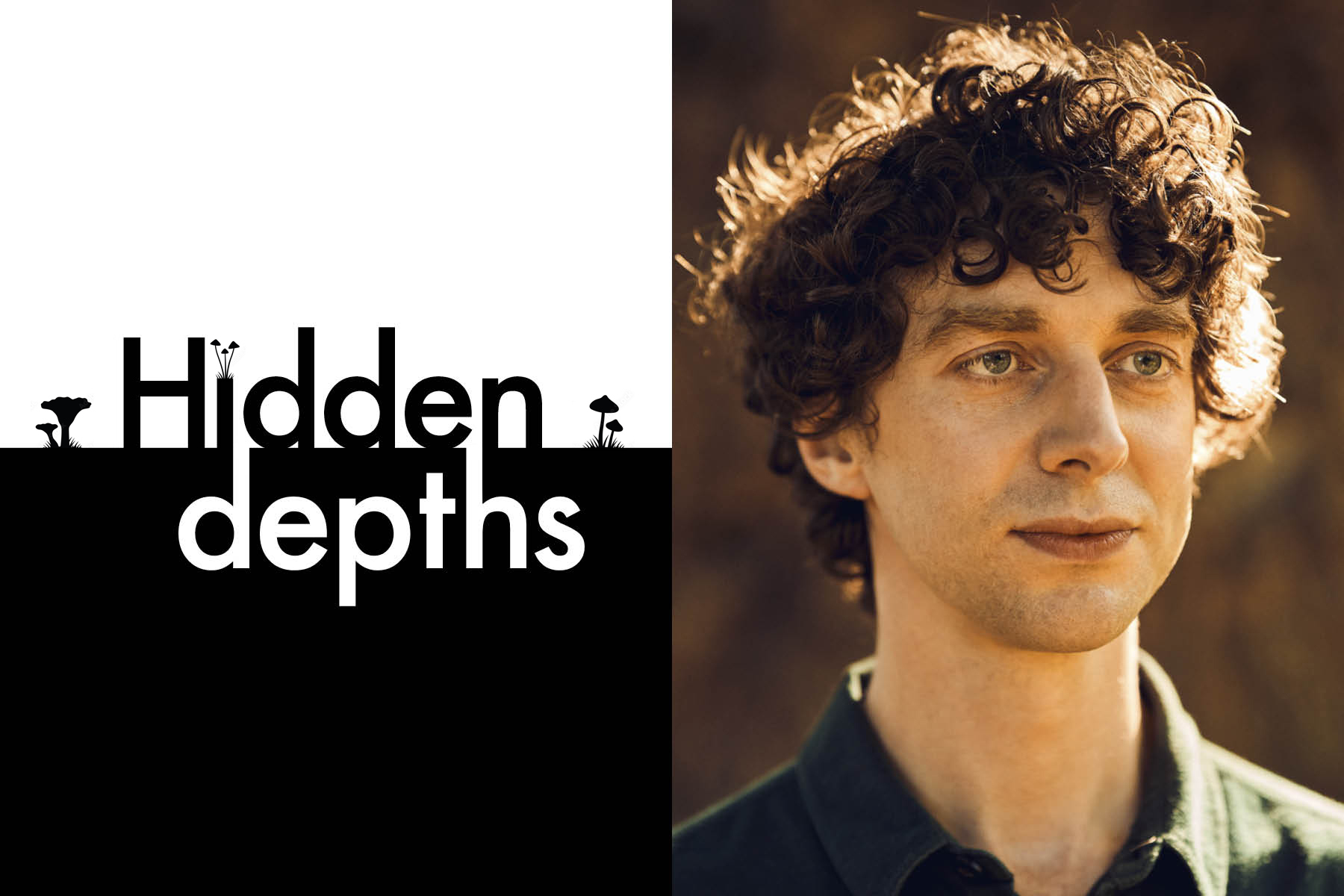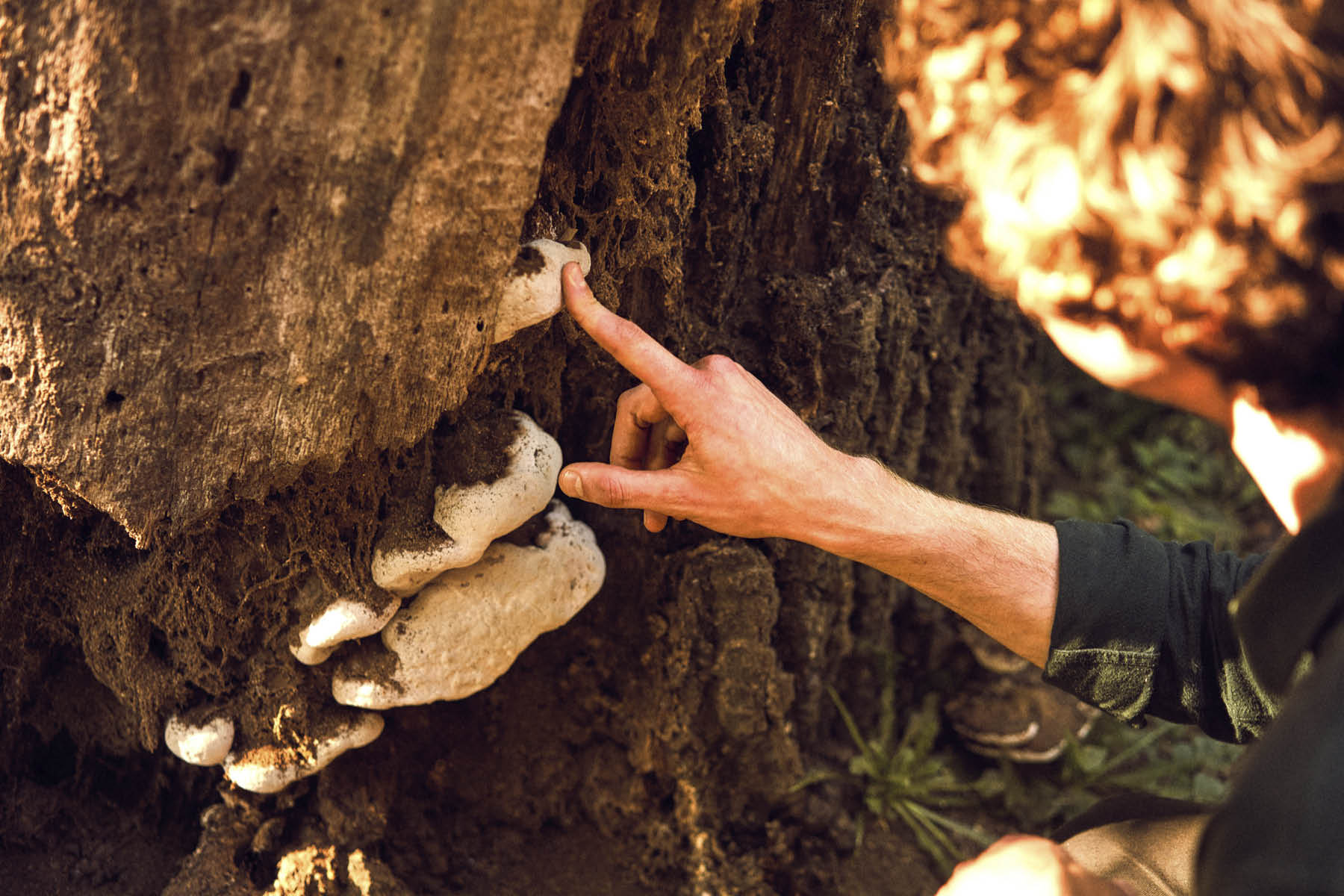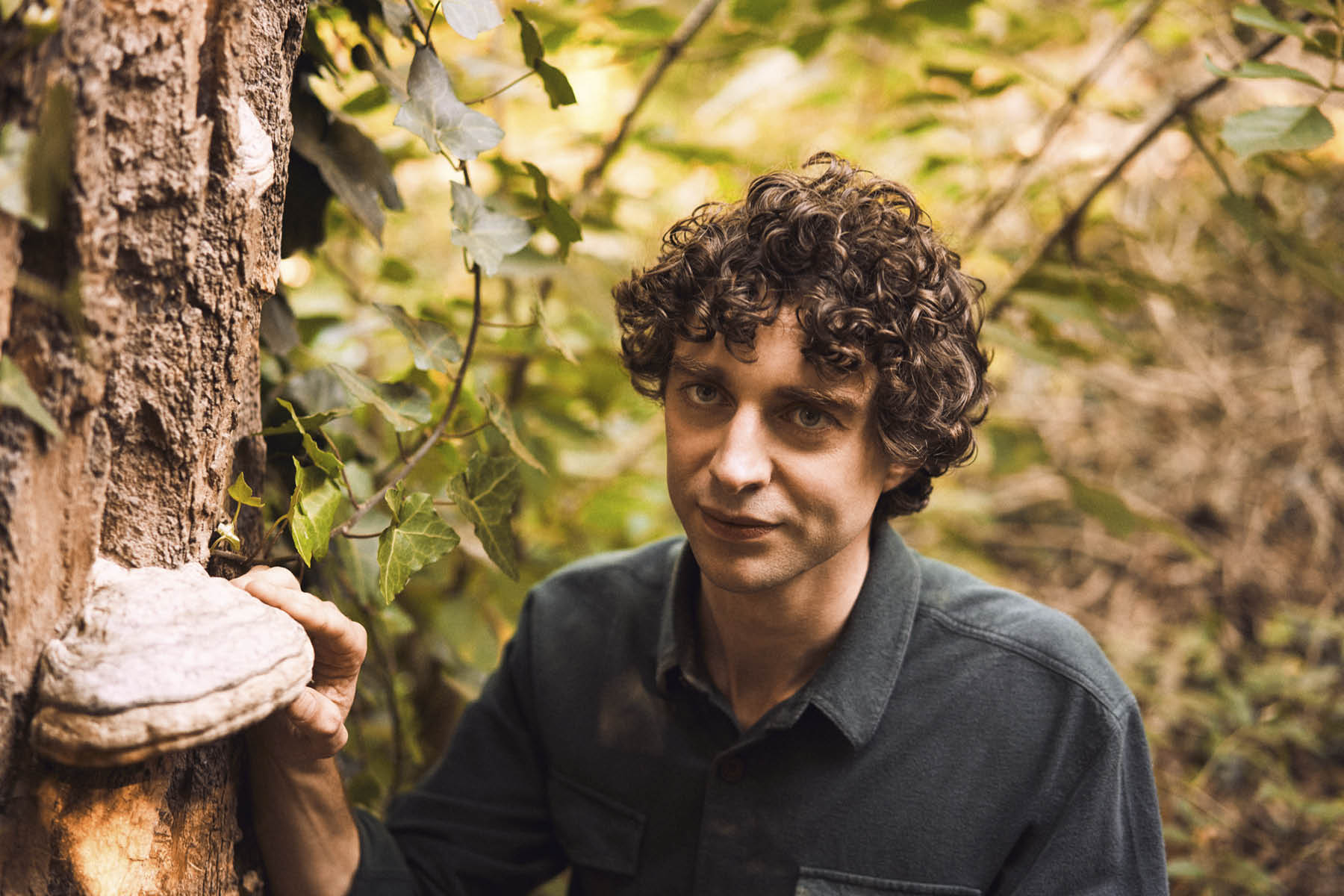
- Home |
- Search Results |
- How Merlin Sheldrake fascinated us with fungi
How Merlin Sheldrake fascinated us with fungi
Entangled Life, the bestselling, award-winning examination of how fungi upholds our world, has dazzled readers. We go mushroom-hunting with its author, Merlin Sheldrake.
It’s a beautiful, blustery late September afternoon on Hampstead Heath. Joggers, dog walkers and sunbathers abound. The lido plays host to a dozen autumnal swimmers. Mountain bikers criss cross the more wooded areas. And, a 10-minute walk inside the park’s boundaries, author Merlin Sheldrake is leading us off the path, through a growth of nettles and brambles, past a discarded Smirnoff bottle to show us something behind a tree.
“Fomes fomentarius,” he begins, kneeling in the undergrowth beside a tremendous, 15-inch white and grey growth in the shape of a run-over wizard’s hat. Sheldrake who is soft-spoken, tall and slim with a shock of tight curls on his head and a pearl necklace wrapped around his wrist, is utterly at home as he shuffles about this small patch of wilderness in pursuit of his greatest passion: fungi. He has been aware of the fomes fomentarius on this tree for quite some time, and has earmarked it for our photoshoot as a great example of the fungi that grow (often unnoticed) all around us.
It turns out, Sheldrake explains, that this particular fungi has quite the history with humans. Also known as ‘tinder fungus’, this fungi was found in a pouch carried by the Ice Man, a well preserved neolithic corpse believed to have lived in the Austrian Alps around 7,000 years ago. “They used the mushroom as a king of kindling, a way to carry fire, which was incredibly important,” he explains. “It was also used to make a kind of felt-like material. It’s an important fungus and recently was also found to be able to extend the life of bees.”

It is incredible that something that was once so important to humans has been forgotten, yet it persists, humbly, behind an unassuming tree in one of London’s most popular outdoor spaces. Sheldrake, 32, whose father is a biologist, grew up exploring the nooks and crannies of Hampstead Heath before going on to study the mycorrhizal fungi that form a symbiotic with plant roots at PHD level.
“I went to study fungi in Panama and that really took me deeper into the fungi world,” he explains. “When people get interested in fungi, often the interest escalates pretty quickly into a helter-skelter of ever deepening fascination.”
Last year, this interest sprouted into Entangled Life: How Fungi Make Our Worlds, Change Our Minds And Shape Our Futures. The book, out now in paperback, was a surprise runaway success, becoming a Sunday Times and Washington Post bestseller and winning last year’s Wainwright Prize.
'I just wanted to draw people’s attention to these remarkable organisms'
At first, Sheldrake says he wasn’t certain that he wanted to write such a book, but eventually realised that fungi are largely unrepresented in scientific literature and also in society at large. The book, then would be an opportunity to address our collective “fungus blindness”.
“It’s fair enough because most of them live underground or out of sight, but what we’re blind to we so often destroy or exploit,” he explains. “I just wanted to draw people’s attention to these remarkable organisms.”
Sheldrake explains that fungi “embody a fundamental principle of ecology, the connection between organisms”. That is, without fungi, the living world as we know it would not exist.

“All plants depend on fungi,” Sheldrake explains. “They create the conditions for plants to grow either as symbiotic partners for roots or by decomposing material to make soil.” If fungi didn’t decompose wood, he explains, the world would be piled high with the bodies of animals and plants – a shocking thought that shows just how important fungi is, especially in the context of current conversations around rewilding and carbon capture. “We live and breath in the space that fungi leaves behind,” Sheldrake says. “When we talk about carbon capture in forests, all of that activity is made possible by fungi.”
In fact, it is thanks to fungi that our ancestors existed at all. Long before chilly neolithic explorers utilised certain fungi as fire-starters, fungi helped the very first plants crawl out of the primordial soup and help create the conditions for life on land around 500 million years ago.
“The ancestors of plants were algae,” Sheldrake explains. “Algae could survive in water in this rich nutrient broth but when they started washing up onto the shores of lakes and rivers they then had to start getting their nutrients from the ground, and they weren’t adapted to that. They struck up a relationship with fungi and they were able to explore and forage by starting a trading relationship, using fungi as a root system until they could develop their own roots.” In that way, Sheldrake explains, fungi are an even more fundamental part of plants than roots or leaves or wood.
There are fungi that survive on kerosene
It’s clear, then, that there is so much more to fungi than just foraging for mushrooms. (Mushrooms are the reproductive organs of fungi, but very few fungi actually exist in mushroom form). There are an estimated 2.8 to 3.2 million species of fungi in the world, yet only eight per cent of them have been described. Yeast is a fungi. There are fungi that survive on kerosene. There are fungi that can break down rock, and in fact, fungi that by forming a symbiotic relationship with lichens have put historic monuments such as Mount Rushmore and the Easter Island heads at risk of destruction, prompting frequent jet-washing.
The largest living organism on planet earth is a fungi, spreading over 2,384 acres of the Malheur National Forest in Oregon. Meanwhile, scientists on the International Space Station have found that certain fungi can survive in space, prompting Sheldrake to mention the theory that fungi originated elsewhere, and the idea that life can travel between terrestrial bodies – a theory called panspermia.
But, before we can go off searching for space mushrooms (which sounds like the title of a 1970s sci-fi B-movie), Sheldrake explains that there is still much to discover about fungi here on earth. “There’s so much we don’t know about fungi,” he says. “Even very basic things about their lives are unknown.” For example, how do they coordinate their networks, which are constantly changing shape, without a brain?

Sheldrake is unsure why Entangled Life has been such a success, but certainly his talent in discussing these sort of questions plays a part. “It certainly felt that [the book] came out of a time when people were thinking more about our relationship to the world and each other,” Sheldrake says. “Fungi is having a moment right now for a number of reasons, so I think the book came into well fertilised ground. But I was surprised; I didn’t think people would want to nerd out as much about fungi.”
Perhaps there is another answer; fungi represents natural design at its simplest, and finest. It’s a reminder that there is a purpose and a shape to everything, even the largely unknown. By studying this Sheldrake hopes we might even be able to alter our own way of looking at the world. “Fungi are so strange and baffling and confound so many of our concepts,” he says. “I think studying that can help get us out of negative patterns of thought and understanding into new ways of thinking.”
Perhaps, that is something we all might benefit from.
What did you think of this article? Email editor@penguinrandomhouse.co.uk and let us know.
Image: Stuart Simpson/Penguin